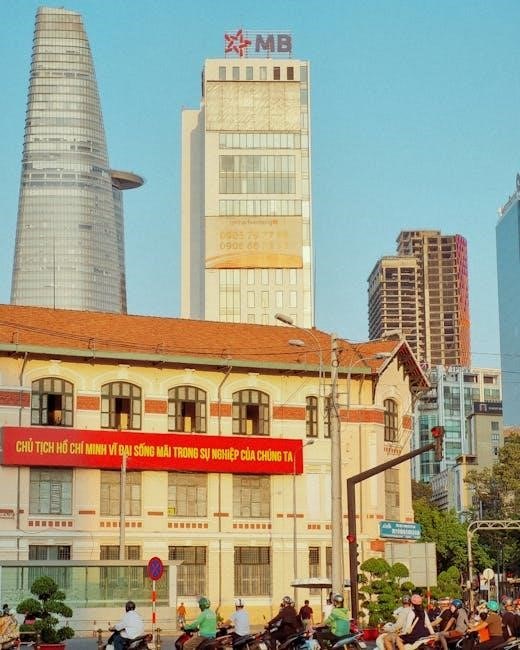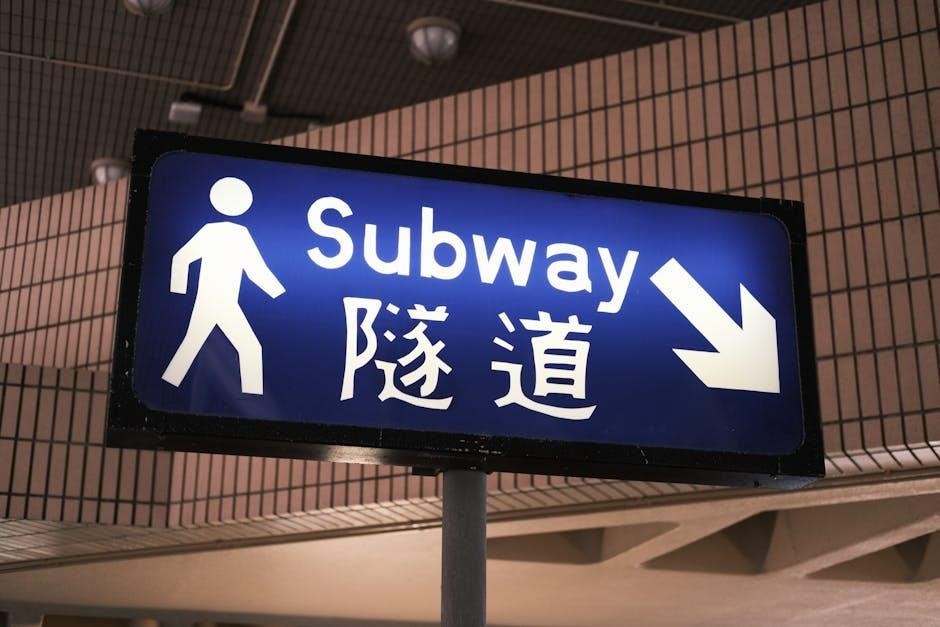
The RTA Guide serves as a comprehensive resource outlining all aspects of traffic generation considerations related to developments. It provides essential information for submitting and assessing development applications.
Purpose of the RTA Guide
The primary purpose of the RTA Guide to Traffic Generating Developments is to offer clear and concise information regarding traffic-related issues. The guide is designed for individuals involved in submitting development applications and those responsible for assessing their potential traffic impacts. It serves as a key reference document for addressing these impacts effectively.
The guide aims to provide a standardized framework for evaluating the traffic implications of land use developments, ensuring consistency and transparency in the assessment process. By outlining the essential considerations and requirements, the guide facilitates informed decision-making by developers, planners, and road authorities. It strives to balance development needs with the need to maintain safe and efficient traffic flow.
Ultimately, the RTA Guide aims to promote sustainable development practices by integrating traffic management principles into the planning and design stages of new developments, minimizing congestion, and ensuring the safety of all road users.
Target Audience and Scope
The RTA Guide to Traffic Generating Developments is primarily aimed at a diverse audience involved in the planning, design, and assessment of land developments. This includes developers, traffic engineers, urban planners, consultants, and government authorities responsible for reviewing and approving development applications. The guide provides crucial information for all stakeholders involved in managing the traffic impacts of new developments.
The scope of the guide encompasses all aspects of traffic generation considerations related to various types of developments, including residential, commercial, industrial, and mixed-use projects. It addresses issues such as trip generation rates, traffic impact assessments, mitigation strategies, and design requirements for roadworks and traffic signals; The guide provides a comprehensive framework for evaluating and addressing the traffic implications of new developments, ensuring that they are integrated into the existing transportation network.
It covers both the strategic design requirements and the updated traffic survey methodologies, making it a valuable resource for anyone involved in development projects.

Key Considerations in Traffic Impact Assessments
Traffic impact assessments are essential for understanding how new developments affect existing traffic systems. These assessments identify potential issues and propose mitigation strategies to minimize negative impacts on road networks.
Identifying Traffic Impacts
Identifying traffic impacts is a crucial step in the assessment process, involving a detailed analysis of how a proposed development will affect the surrounding road network. This includes evaluating potential increases in traffic volume, changes in traffic patterns, and the impact on existing infrastructure.
Key factors to consider are trip generation rates, which estimate the number of trips a development will generate, and traffic distribution, which determines where those trips will occur. Analyzing peak hour traffic is essential to understanding the maximum impact on the road system.
Furthermore, the assessment must consider the impact on vulnerable road users such as pedestrians and cyclists. Identifying these impacts early allows for the development of effective mitigation strategies, ensuring the safe and efficient operation of the transportation network. Understanding these impacts is vital for sustainable development.
Mitigation Strategies for Development Traffic
Effective mitigation strategies are crucial for addressing the traffic impacts of new developments, ensuring minimal disruption to the existing road network. These strategies aim to reduce congestion, improve safety, and promote sustainable transportation options. Common mitigation measures include optimizing intersection design, implementing traffic signal coordination, and constructing new roadways.
Enhancements to public transportation, such as bus rapid transit or light rail systems, can significantly reduce reliance on private vehicles. Promoting cycling and walking through dedicated infrastructure, such as bike lanes and pedestrian walkways, also contributes to reducing traffic volume.
Furthermore, implementing travel demand management strategies, such as flexible work hours and carpooling programs, can help to distribute traffic more evenly throughout the day. The successful implementation of these strategies requires careful planning, coordination, and ongoing monitoring to ensure their effectiveness. Careful analysis can help reduce traffic.

Strategic Design Requirements for Development Applications
Strategic design requirements are key for development applications. They outline the minimum design information needed for roadworks or traffic signals. This ensures developments integrate effectively with existing infrastructure and meet safety standards.
Minimum Design Information Required
Development applications necessitating roadworks on State roads or traffic signals on any road must include comprehensive design information. This ensures adherence to RTA guidelines and facilitates thorough assessment. The provided information should cover all relevant aspects of the proposed design, including detailed geometric layouts, pavement design, drainage considerations, and signage plans.
Furthermore, applications need to specify the design life of the proposed infrastructure, as well as expected maintenance requirements. Traffic modeling data, demonstrating the impact of the development on traffic flow and safety, is also crucial. Integration with existing infrastructure, such as utilities and public transport, should be clearly addressed. This detailed information enables informed decision-making and minimizes potential disruptions.
Moreover, applications should outline proposed construction methodologies and traffic management plans during construction. Environmental considerations, including noise and air quality impacts, must be addressed. Detailed landscaping plans and visual impact assessments may also be required, ensuring the development integrates harmoniously with its surroundings.
Roadworks and Traffic Signals on State Roads
Any development application proposing roadworks or traffic signals on State roads requires meticulous attention to detail. Proposals must adhere strictly to RTA standards and guidelines, ensuring the safety and efficiency of the State road network. Early consultation with the RTA is essential to discuss project scope and potential impacts. Detailed design plans, including geometric layouts, pavement design, and drainage, must be submitted for review.
The application should clearly demonstrate how the proposed works integrate with existing infrastructure and traffic management systems. Traffic impact assessments must be comprehensive, evaluating the effects on traffic flow, safety, and accessibility. Mitigation strategies to minimize disruption during construction are critical. Furthermore, the application must address environmental considerations, including noise and air quality impacts, and provide appropriate mitigation measures.
Approvals from the RTA are mandatory before commencing any roadworks or signal installations on State roads. Ongoing communication with the RTA throughout the project lifecycle is vital to ensure compliance and address any emerging issues. The ultimate goal is to enhance road capacity and speed, thus improving the transportation network.

Updated Traffic Surveys and Trip Generation Rates
This section focuses on the importance of current data in assessing traffic impacts. It highlights revisions to trip generation rates from previous guides and underscores the need for accurate, up-to-date surveys.
Importance of Current Data
The accuracy of traffic impact assessments relies heavily on the use of current and relevant data. Utilizing outdated information can lead to inaccurate projections, inadequate mitigation strategies, and ultimately, adverse traffic outcomes. Updated traffic surveys and trip generation rates are crucial for reflecting current travel patterns and land use characteristics.
The RTA recognizes that traffic patterns evolve over time due to various factors such as population growth, changing demographics, economic development, and transportation infrastructure improvements. Therefore, relying on older data from previous guides may not accurately capture the existing traffic conditions and future traffic demands associated with new developments.
The use of current data ensures that traffic impact assessments are based on the most realistic and representative information available. This enables decision-makers to make informed judgments regarding the potential traffic impacts of proposed developments and to implement appropriate mitigation measures to minimize any adverse effects.
Changes from Previous Guides
The updated RTA Guide incorporates significant changes from previous versions to reflect current best practices and address evolving traffic management challenges. One key modification is the inclusion of updated traffic surveys and trip generation rates. These revisions are based on recent data collection efforts and analysis, providing a more accurate representation of current travel patterns and land use characteristics.
Furthermore, the updated guide may include revised methodologies for conducting traffic impact assessments, incorporating new technologies and modeling techniques. These changes aim to improve the accuracy and reliability of traffic projections, enabling more effective mitigation strategies.
The updated guide may also incorporate changes to strategic design requirements for development applications, particularly regarding roadworks and traffic signals on State roads. These revisions may reflect updated safety standards, design guidelines, or regulatory requirements. Developers and traffic professionals should carefully review the updated guide to ensure compliance with the latest requirements.

Responsibilities of the Guide Owner
The guide’s owner must advise the RTA of title, address, or ownership changes. Ensuring revisions are inserted and obsolete pages removed is also a crucial responsibility for keeping the document current and accurate.
Advising the RTA of Changes
As the designated owner of the “Guide to Traffic Generating Developments,” a critical responsibility is maintaining open communication with the Roads and Traffic Authority (RTA). This involves promptly advising the RTA of any modifications to your title, change of address, or transfer of ownership pertaining to the guide itself. Timely notification ensures that the RTA’s records remain accurate and up-to-date, facilitating effective communication regarding revisions, updates, or any other relevant information concerning the guide’s content and application.
Failing to inform the RTA of such changes can lead to delays in receiving crucial updates, potentially resulting in the use of outdated information and non-compliance with current standards. Therefore, adhering to this responsibility is paramount for maintaining the guide’s integrity and ensuring its effective use in traffic-related development assessments. It is also important for the RTA to maintain an accurate record of who is responsible for the document.
Ensuring Revisions are Inserted
A primary duty as the owner of the “Guide to Traffic Generating Developments” is to meticulously manage revisions. This involves ensuring that all updates, amendments, and modifications issued by the RTA are promptly and accurately incorporated into the guide. This includes the insertion of new pages, the replacement of obsolete sections, and the removal of outdated information.
This proactive approach to revision management guarantees that the guide remains current and reflects the latest standards, guidelines, and best practices in traffic engineering and development planning. Neglecting to insert revisions can lead to the use of obsolete information, resulting in inaccurate assessments, non-compliant designs, and potential safety hazards.
Therefore, diligent revision management is essential for maintaining the guide’s reliability and effectiveness as a tool for informed decision-making in traffic-generating developments. This also ensures the document is fit for purpose.